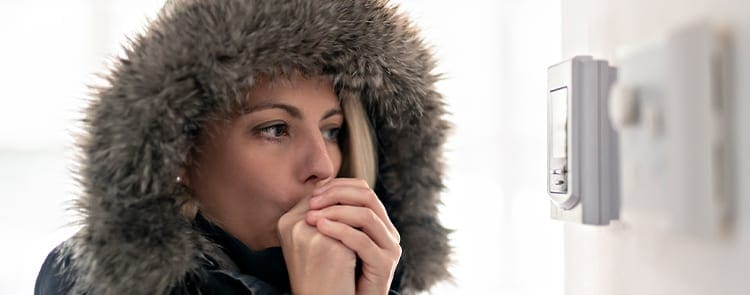Blogs
No Heat? Self Diagnose Thermostat First
3/7/2015

If your thermostat says heat is on, but you have no heat, there are many things you can do to troubleshoot the situation before having to call in a professional, including taking the proper steps to diagnose your thermostat.
Although sometimes there is an actual problem with your HVAC system, you’d be surprised how many times the issue lies with the thermostat itself. Before calling a professional, take the time to do a little thermostat self-diagnosis. No experience is needed.
5 Ways to Troubleshoot Your Thermostat
- Check Power, Heat, and Fan. Before moving on to the list, make sure your thermostat is correctly set to “heat,” that the temperature setting is above the room temperature, and that your furnace’s power switch and circuit breaker are on and receiving power. If you are experiencing constant blower or fan operation, check the fan setting and make sure it is set to “auto.”
- Check the Batteries. The first thing you want to do is make sure that your thermostat has the power needed to operate. Although some thermostats do not require batteries, most do. If you have never opened up your thermostat housing to replace the batteries, here is a good video showing you how.
- Dust the Inside. Since you now know how to open up your thermostat, now is a good time to blow or brush off any dust or debris that has accumulated inside. Especially for older electromechanical models, dust and other material can affect temperature readings and other interior parts. Use a paintbrush or other small brush to remove any dust and a soft piece of paper to get in between the coils and contact plates.
- Location, Location, Location. You want to make sure that your thermostat is out of the way of any heat source, including direct sunlight, heating vents, lamps, space heaters, or anything else that may affect your thermostat’s temperature readings. The furnace will not turn on if it already thinks that it has reached the desired temperature.
- Adjust the Anticipator and Level the Mercury Switch. The last thing to watch out for is your anticipator’s setting and the balance of your mercury switch. The anticipator is located inside of your thermostat housing.
The anticipator, as the name suggests, anticipates when your cooling or heating cycles should turn on or off. If you find that your furnace (or A/C) turns on and off too frequently (or not frequently enough), you should adjust the anticipator’s setting. If the heat never seems to reach the desired temperature, turn the anticipator’s small metal adjustor away from the “longer” setting and closer to the shorter setting (and vice versa).
The mercury tube in your thermostat also needs to be adjusted if necessary. Make sure that your thermostat and mercury tube are exactly level. Use a laser level or other tool to straighten your thermostat.
Other Solutions
If none of these steps have solved your problem, you either have a mismatched thermostat or the problem lies within the furnace itself. The best way to make sure you have a reliable and efficient heating system is to have thermostat installations done by a professional who can correctly match the thermostat to your system and always remember to schedule annual heating and cooling tune-ups.
Before calling us, however, make sure you have a clean air filter in your furnace and that the blower door is completely shut. Sometimes it’s a little fix and does not require professional service.
Heating and Cooling Des Moines Since 1997
At Service Legends, we take pride in heating and cooling Des Moines and the surrounding areas. Our HVAC services include furnace and air conditioner installation, repairs, maintenance, and tune-ups. Our lineup of Indoor Air Quality solutions includes whole-home humidifiers, air purifiers, and air filtration systems. We can even help with HVAC financing.
Call 515-657-6634 to contact our Home Comfort Heroes today. We’re standing by 24/7.
515-657-6634Request Appointment Online
Related Content
- Should You Set Your Thermostat Fan to Auto?
- How to Use A Programmable Thermostat for Max Savings
- Save Money This Winter With a Programmable Thermostat
- January 2024
- October 2023
- September 2023
- August 2023
- January 2023
- December 2022
- November 2022
- October 2022
- September 2022
- August 2022
- July 2022
- June 2022
- May 2022
- April 2022
- March 2022
- February 2022
- January 2022
- May 2021
- November 2020
- October 2020
- September 2020
- July 2020
- June 2020
- May 2020
- March 2020
- February 2020
- December 2019
- November 2019
- September 2019
- May 2019
- April 2019
- January 2019
- December 2018
- November 2018
- October 2018
- July 2018
- October 2016
- September 2016
- August 2016
- July 2016
- June 2016
- May 2016
- April 2016
- March 2016
- February 2016
- January 2016
- December 2015
- November 2015
- October 2015
- September 2015
- August 2015
- July 2015
- June 2015
- May 2015
- April 2015
- March 2015
- February 2015
- January 2015
- December 2014
- November 2014
- October 2014
- September 2014
- August 2014
- July 2014
- May 2014
- March 2014
- February 2014
- January 2014
- December 2013
- November 2013
- October 2013
- September 2013